WORLD CLASS COACHING
Build Up From the Back - Exercises 1
By Luca Bertolini
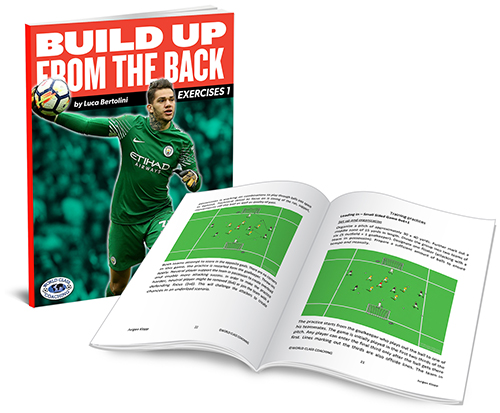
Table of Contents
PART THREE
Switching Play From Flank to Flank
Switching Play From Flank to Flank
These might be the main reasons why a team plays out from the back:
• The team does not have particularly tall players, lacking a target player that can hold the ball up to avoid the risk of losing possession if the ball is kicked long
• The players are technically skilled and the possession has to be retained
• Team is slow at counter attacking
• Opposition is organized and the options for counter attacks are too risky.
• To draw the opposition higher up the field to create space or build an attack.
• To set the tempo and the rhythm of a game
• To control the possession of the ball during the main part of the game
• To move the opposition throughout the whole field
• To create spaces and to exploit them behind the pressure lines
• To switch the side of play when the pressure of the opposition cannot be overcome, or the spaces and the forward passing lanes in the middle third are closed
• To produce technically better players that can play in tight spaces under pressure, talking about youth academy
All the following patterns of play and sequences can be useful to build up from the goalkeeper and also to play out when the team is under pressure and it has to play back to switch the side.
Playing out from the back is not only a task of passing the ball by and between the defenders to midfielders and then to the strikers or wherever the game progresses, but it's a style of play to overcome the opposition pressure when possible, to invite the opposition out to create space, as well as the possession tool to switch the side and to move the opponents, alternating strong and weak sides.
Synchronized movements play a key role as defenders and midfielders need to create space and channels for the ball to be played into and forward if they play out from the back, and they all have to create passing options to come back and switch the side with the fewest number of passes possible.
The pitch should be made big as the goalkeeper is in possession to start a move and when the possession is regained. Every player on the ball should have numerous options due to movements and angles made by the teammates; one side option, one back option and one forward option at least.
All the following patterns of play are created to build up from the back, to play out and to switch the side against six opponents, up the field (3 - 3) that are represented by the air-bodies. As the combination allows the player in possession to take the move to the final stage, the same sequence to play out from the back is then simulated to avoid the pressure of the opposition and to switch the side to find new spaces along the weak side of the opposition.
All the patterns of play are not specific for a system of play and the players are placed on the pitch in useful positions and angles to progress up to it.
Exercise 21: play out switching the side (8+gk v "6")
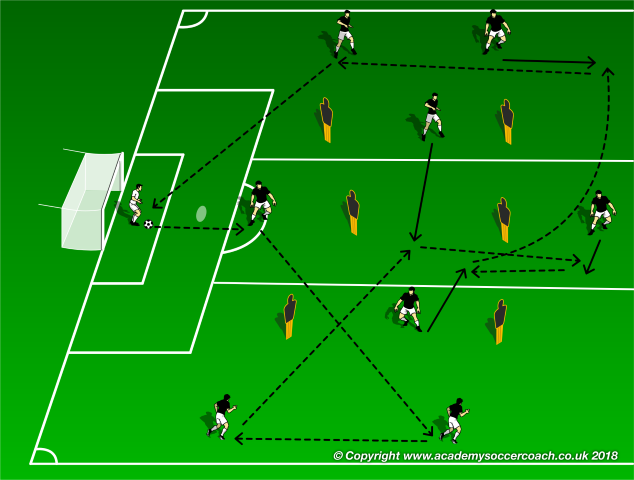
Set-up and Sequence: one goalkeeper and eight players are placed inside a half of a pitch; six air-bodies are placed in the middle to simulate three pressing forwards and three midfielders behind them (3-3). The players of the possession team are the center backs, the fullbacks, three midfielders and one forward or advanced midfielder. The half field is vertically divided into three parts.
The goalkeeper passes the ball to the center midfielder who then plays wide on the right side where a 3 v 2 duel is being simulated; the middle and the right part of the field are now overload.
The side of play is then switched to the left side through the center where a fast passing combination is played to solve a potential 4 v 2 duel. The left fullback receives over the second line of pressure and he passes back to the center back and then to the goalkeeper, to play out as if the team were under pressure.
Eye on: quality of the passes, quick combinations to switch the side, fast replacing on the field to play out.
Exercise 22: play out switching the side (8+gk v "6")
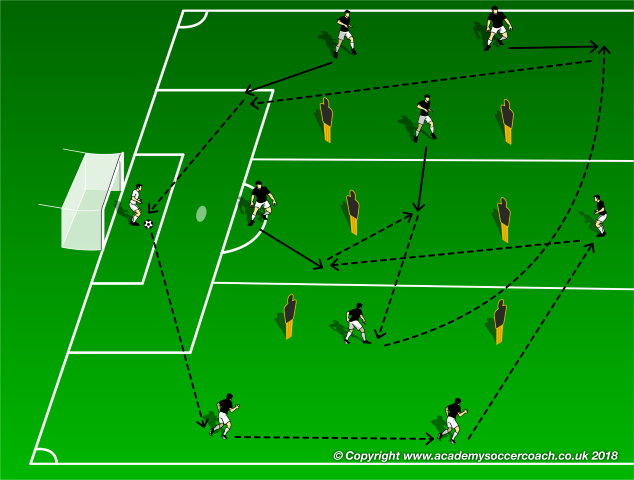
Set-up and Sequence: one goalkeeper and eight players are placed inside a half of a pitch; six air-bodies are placed in the middle to simulate three pressing forwards and three midfielders behind them (3-3). The players of the possession team are the center backs, the fullbacks, three midfielders and one forward or advanced midfielder. The half field is vertically divided into three parts.
The goalkeeper passes the ball to the center back who then plays forward to the fullback on the right side, where a 3 v 2 duel is being simulated; the middle and the right part of the field are now overloaded.
The side of play is then switched to the left side from the right one, after a quick passing combination in the center to solve a potential 3 v 2 duel. The left fullback receives over the second line of pressure and he passes back to the center back and then to the goalkeeper, to play out as if the team were under pressure.
Eye on: quality of the passes, quick combinations to switch the side, fast replacing on the field to play out.
Exercise 23: play out switching the side (8+gk v "6")
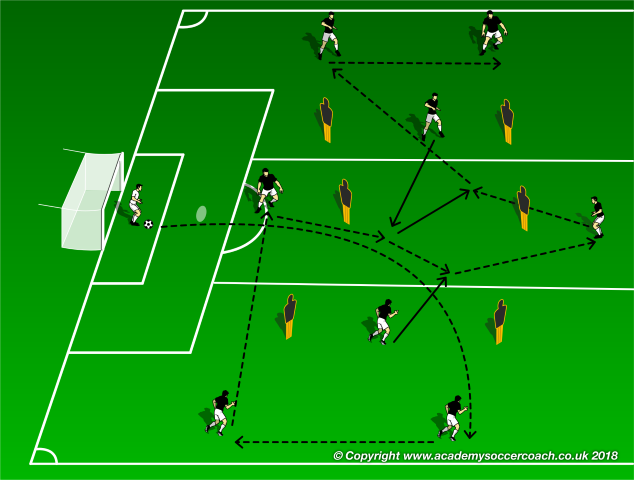
Set-up and Sequence: one goalkeeper and eight players are placed inside a half of a pitch; six air-bodies are placed in the middle to simulate three pressing forwards and three midfielders behind them (3-3). The players of the possession team are the center backs, the fullbacks, three midfielders and one forward or advanced midfielder. The half field is vertically divided into three parts.
The goalkeeper plays a long ball to the fullback, who then passes to the center back on the right side, where a 3 v 2 duel is being simulated; the middle part of the field is now overload.
The side of play is then switched to the left side from the center after a quick passing combination, to solve a potential 4 v 2 duel. The left center back receives on the defense line and he passes forward toward the fullback.
The sequence ends with a back pass to the goalkeeper or with a pass to the center midfielder to play out as if the team were under pressure.
Eye on: quality of the passes, quick combinations to switch the side, fast replacing on the field to play out.
Exercise 24: play out switching the side (7+gk v "6")
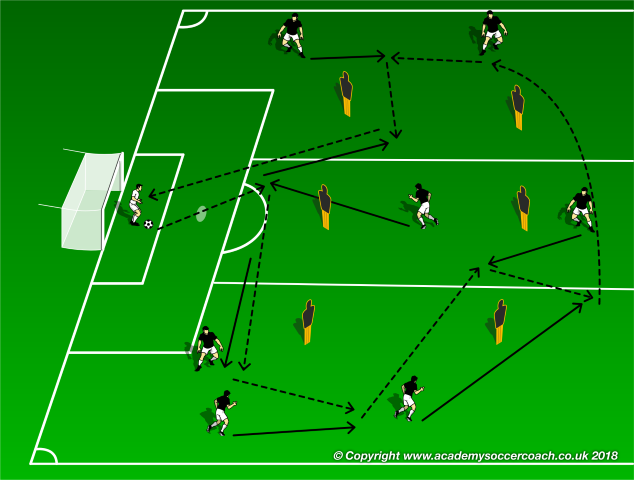
Set-up and Sequence: one goalkeeper and seven players are placed inside a half of a pitch; six air-bodies are placed in the middle to simulate three pressing forwards and three midfielders behind them (3-3). The players of the possession team are the center backs, the fullbacks, two midfielders and one forward or advanced midfielder. The half field is vertically divided into three parts.
The goalkeeper passes the ball to the dropping back center midfielder, who then passes out to the center back who is shifting wide on the right flank, to create a simulated 3 v 2 duel; an equal number of players (2 v 2) act in the middle part of the field.
The side of play is then switched to the left side from the right one, after a 3rd man passing combination near the center area. The left fullback receives and he passes back to the center back.
The sequence ends with a back pass to the goalkeeper from the center balance player who received before, to play out as if the team were under pressure.
Eye on: quality of the passes, quick combinations to switch the side, fast replacing on the field to play out.
Exercise 25: play out switching the side (7+gk v "6")
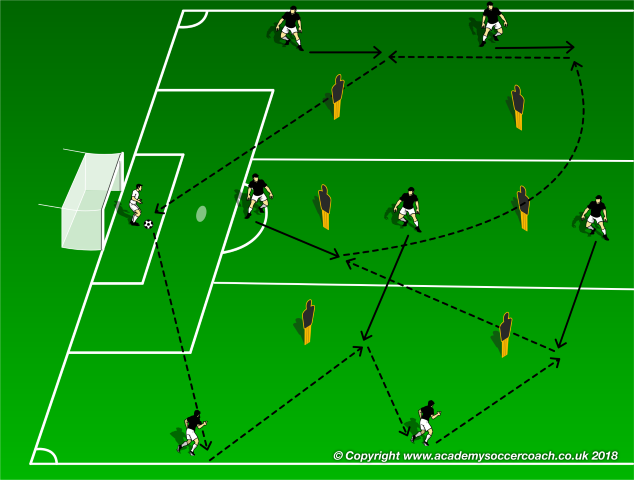
Set-up and Sequence: one goalkeeper and seven players are placed inside a half of a pitch; six air-bodies are placed in the middle to simulate three pressing forwards and three midfielders behind them (3-3). The players of the possession team are the center backs, the fullbacks, two midfielders, and one forward or advanced midfielder. The half field is vertically divided into three parts.
The goalkeeper passes the ball to the fullback, who then passes inside toward one of the incoming midfielders, shifting wide on the right flank to create a simulated 4 v 2 duel, as the forward has dropped back there too. An equal number of players (2 v 2) act in the middle part of the field.
The side of play is then switched to the left from the center very quickly, as the center midfielder is potentially in numerical disadvantage (1 v 2); the fullback receives and he passes back to center back. The sequence ends with a pass back to the goalkeeper from the center back who received before, to play out as if the team were under pressure.
Eye on: quality of the passes, quick change of side under pressure, creation of a strong side, fast replacing on the field to play out.
Exercise 26: play out switching the side (7+gk v "6")
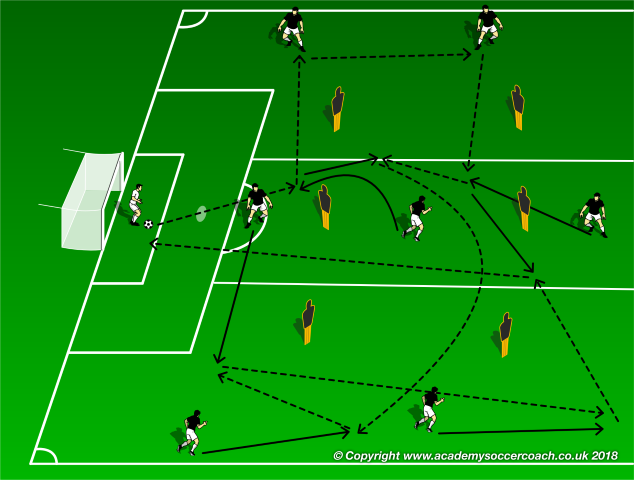
Set-up and Sequence: one goalkeeper and seven players are placed inside a half of a pitch; six air-bodies are placed in the middle to simulate three pressing forwards and three midfielders behind them (3-3). The players of the possession team are the center backs, the fullbacks, two midfielders, and one forward or advanced midfielder. The half field is vertically divided into three parts.
The goalkeeper passes the ball to one dropping back center midfielder in front of the first line of pressure, who then passes forward to the center striker who dropped back too and who plays out wide on the left side. The center back receives and he passes forward to the fullback.
The side of play is then switched to the right side from the left, after a quick passing combination inside the center area, where a 3 v 2 duel has to be solved. The right center back receives and he passes back to the center midfielder, who shifts across to create numerical advantage 3 v 2. The sequence ends with a back pass to the goalkeeper of the center forward, to play out as if the team were under pressure.
Eye on: quality of the passes, quick combinations to switch the side, fast replacing on the field to play out.


